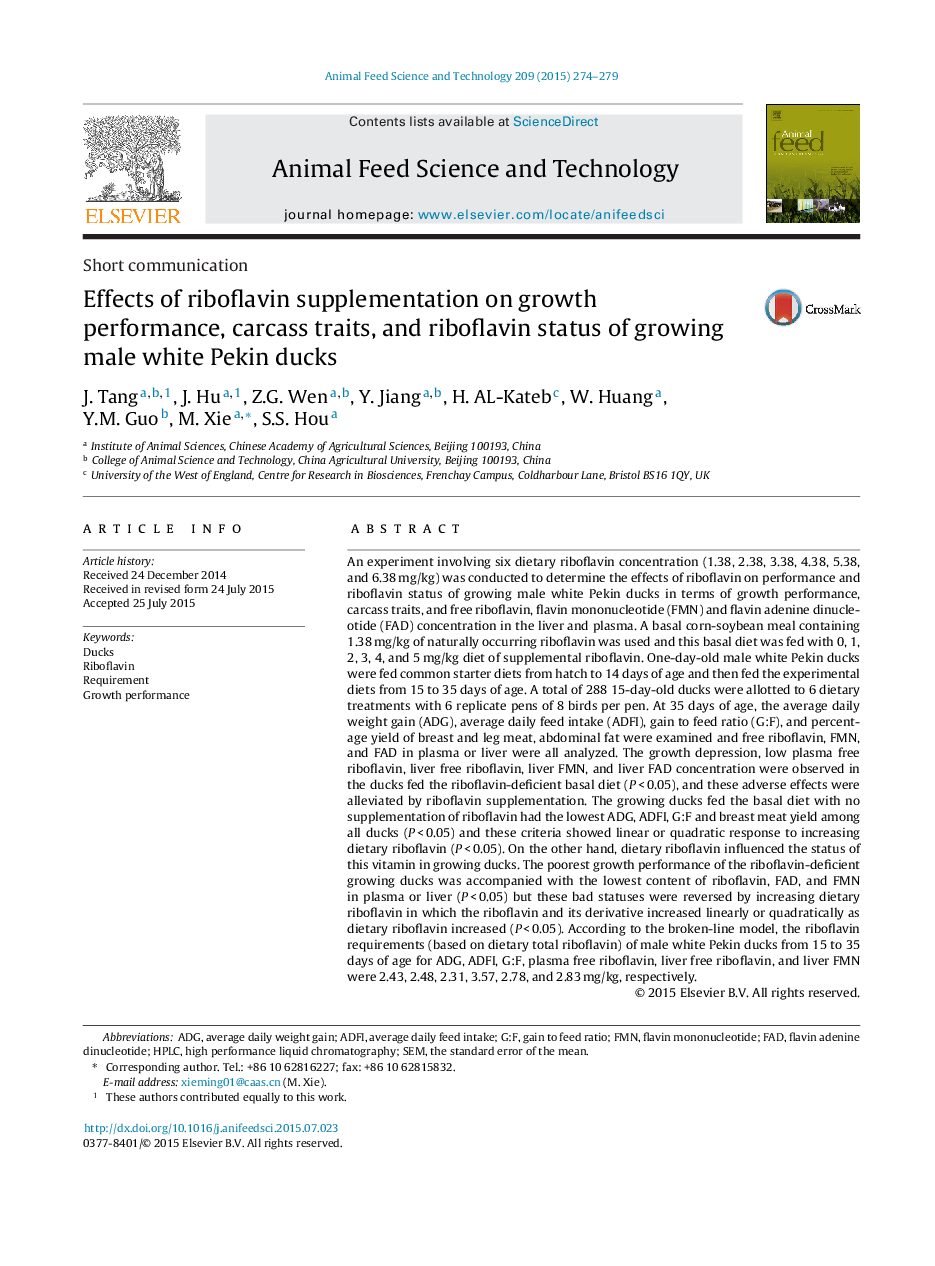| کد مقاله | کد نشریه | سال انتشار | مقاله انگلیسی | نسخه تمام متن |
|---|---|---|---|---|
| 2419393 | 1552376 | 2015 | 6 صفحه PDF | دانلود رایگان |
• Growing male Pekin ducks need less riboflavin than starter birds.
• The riboflavin requirements of growing male white Pekin ducks estimated by this study were lower than the recommendation of NRC (1994).
• Riboflavin status of ducks could be indicated by plasma or liver riboflavin.
An experiment involving six dietary riboflavin concentration (1.38, 2.38, 3.38, 4.38, 5.38, and 6.38 mg/kg) was conducted to determine the effects of riboflavin on performance and riboflavin status of growing male white Pekin ducks in terms of growth performance, carcass traits, and free riboflavin, flavin mononucleotide (FMN) and flavin adenine dinucleotide (FAD) concentration in the liver and plasma. A basal corn-soybean meal containing 1.38 mg/kg of naturally occurring riboflavin was used and this basal diet was fed with 0, 1, 2, 3, 4, and 5 mg/kg diet of supplemental riboflavin. One-day-old male white Pekin ducks were fed common starter diets from hatch to 14 days of age and then fed the experimental diets from 15 to 35 days of age. A total of 288 15-day-old ducks were allotted to 6 dietary treatments with 6 replicate pens of 8 birds per pen. At 35 days of age, the average daily weight gain (ADG), average daily feed intake (ADFI), gain to feed ratio (G:F), and percentage yield of breast and leg meat, abdominal fat were examined and free riboflavin, FMN, and FAD in plasma or liver were all analyzed. The growth depression, low plasma free riboflavin, liver free riboflavin, liver FMN, and liver FAD concentration were observed in the ducks fed the riboflavin-deficient basal diet (P < 0.05), and these adverse effects were alleviated by riboflavin supplementation. The growing ducks fed the basal diet with no supplementation of riboflavin had the lowest ADG, ADFI, G:F and breast meat yield among all ducks (P < 0.05) and these criteria showed linear or quadratic response to increasing dietary riboflavin (P < 0.05). On the other hand, dietary riboflavin influenced the status of this vitamin in growing ducks. The poorest growth performance of the riboflavin-deficient growing ducks was accompanied with the lowest content of riboflavin, FAD, and FMN in plasma or liver (P < 0.05) but these bad statuses were reversed by increasing dietary riboflavin in which the riboflavin and its derivative increased linearly or quadratically as dietary riboflavin increased (P < 0.05). According to the broken-line model, the riboflavin requirements (based on dietary total riboflavin) of male white Pekin ducks from 15 to 35 days of age for ADG, ADFI, G:F, plasma free riboflavin, liver free riboflavin, and liver FMN were 2.43, 2.48, 2.31, 3.57, 2.78, and 2.83 mg/kg, respectively.
Journal: Animal Feed Science and Technology - Volume 209, November 2015, Pages 274–279
